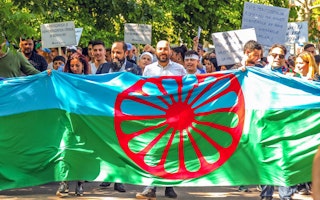Combating Anti-Gypsyism: Nothing Less Than Zero Tolerance Will Suffice
By Bernard Rorke
A longer version of this article appeared on the UNDP site Development and Transition.
One key theme of the United Nations Development Program’s 2003 report Avoiding the Dependency Trap was that “providing Roma with opportunities to develop their talents and make free choices of their own should be at the core of Roma.” The point was that legal frameworks for rights protection are a necessary but insufficient precondition for sustainable integration. There must too be complementarity with an approach that focuses more broadly on development opportunities for Roma.
The impact of the human development paradigm was reflected in the priorities of the Decade of Roma Inclusion back in 2005, and more recently in the EU Framework for National Roma Integration Strategies (NRIS) up to 2020. But the complementarity got lost somewhere along the way, and issues of racism and discrimination have been smothered somewhat by a softer EU emphasis on social inclusion and societal cohesion.
While the European Commission mulls over submissions by Member States in response to the Framework there has been precious little discussion about what is meant by “integration.” Everyone’s talking integration, but too often the model in mind differs very little from assimilation. Following the attacks on multiculturalism emanating from the mainstream right, and the electoral successes of far-right populist parties across democracies old and new, perceptions of integration are increasingly being driven by an assimilationist rationale.
In many nations, the notion of integration has become less hospitably pluralist than before. Less of a two-way process and more of a one-way street, with the onus being placed on the minorities to make the adjustments and accommodations deemed necessary for social cohesion. This rightward shift in the political mainstream has been accompanied by increasingly virulent and frequently violent attacks on marginalized minorities by extremist groupings. And across the European Union, Roma populations are bearing the brunt of populist hostility.
Over 30 years ago Roy Jenkins defined integration “not as a flattening process of assimilation but equal opportunity, accompanied by cultural diversity, in an atmosphere of mutual tolerance.” This definition has weathered well over the years, but today, as Bhikhu Parekh suggests, the key question is not how minorities can be integrated. Rather, the question we should be asking is how members of minority communities can become equal citizens bound to the rest by the ties of common belonging. Integration is best viewed as the means and not the end. Forms of integration should be negotiated and decided by their ability to serve the overall objective of fostering common belonging and dignity for all in the relations between Roma and non-Roma citizens.
Roma integration needs to be understood as a two-way process, an open-ended sequence of negotiated adjustments between citizens. This however does not imply any symmetry in the “negotiated adjustments” between Roma and non-Roma. There is no symmetry when it comes to confronting structured and embedded institutional racism.
The challenges to the ties that might bind citizens remain stark and formidable. Despite last year’s unprecedented moves to promote social inclusion under the aegis of the EU Framework, Roma continued to be vilified and persecuted across the continent throughout 2011. As Thomas Hammarberg’s recent report shows, in the European Union, Roma communities repeatedly came under siege from neo-Nazi paramilitary groups and rioting mobs; public officials, mayors and far-right members of parliament continue to indulge in anti-Roma hate speech with seeming impunity.
Even as the December deadline for member states’ submission of NRIS loomed, an anti-Roma pogrom took place on the outskirts of Turin, following a false claim by a 16-year-old girl that she had been sexually assaulted by “gypsies who had stolen her virginity.” A furious mob of locals set the Roma camp ablaze and destroyed it.
In the same month in the Czech Republic, a dispute erupted about the use on national television of the term “inadaptables” to refer to Romani people. In its response to a complaint the television channel’s legal department stated: “There is nothing racist about it. Human society functions in such a way that minorities assimilate into the majority. Anyone who doesn't understand this is an inadaptable, irrespective of ethnic origin or skin color.”
Unfortunately, there is no shortage of detail when it comes to crude forms of racism visited upon Roma citizens; and there is no shortage of evidence that across EU member states Romani men, women and children encounter institutional racism as a quotidian fact of life. The scale of discrimination and exclusion that Roma face was laid bare in the results of the EU-MIDIS European Union Minorities and Discrimination Survey in 2009. The report found that on average, across nine areas of everyday life, the Roma were discriminated against because of their ethnic background more than all other groups surveyed, including Sub-Saharan Africans and North Africans.
As we complicated our understandings of human rights to include what UNDP calls “the expansion of life choices vital to human dignity,” it’s time now to complicate our understandings of racism. Left unchecked and unchallenged, anti-Roma prejudice threatens to derail progress to the extent that the rise of anti-Gypsyism presents a fundamental threat to the entire Framework for Roma Integration. As UNDP stated more than a decade ago, “development opportunities are inexorably linked to human rights.” The national strategies have failed to make this linkage, and this must be remedied. If the Framework is to “make a difference by 2020,” what is to be done to best combat anti-Gypsyism across the European Union?
A first step would be to look beyond the specifics of Roma exclusion for lessons to be learned. In the UK, the racist murder of black teenager Stephen Lawrence in 1993 prompted the MacPherson Report in 1999. The report prompted a nationwide debate that forced the British public to see more crude forms of racism in a wider context and to confront the complex nature of racism. The most important finding of the report was the prevalence of institutional racism in Britain, defined as:
The collective failure of an organization to provide an appropriate and professional service to people because of their color, culture, or ethnic origin. It can be seen or detected in processes, attitudes and behavior which amount to discrimination through unwitting prejudice, ignorance, thoughtlessness and racist stereotyping which disadvantage minority ethnic people.
With this definition, according to Jenny Bourne, MacPherson set a new benchmark for race relations in Britain, “broken with cultural explanations and remedies, broken with individualized definitions and ethnic identity and put the spotlight on the workings of institutions instead.” The report called on all institutions to examine their policies and practices and stated that “there must be an unequivocal acceptance of institutional racism and its nature before it can be addressed.”
When it comes to Roma inclusion and institutional racism, it is clear that many EU member states remain in deep denial. They need to wake up for the clock is ticking, and member states, old and new alike, need to confront the deeply embedded institutional racism that has undermined, and will continue to undermine, all efforts to promote Roma inclusion.
Governments must adopt an unambiguous and unequivocal zero-tolerance approach to the crude manifestations of anti-Gypsyism from the extremists of the far-right. In addition, there is a need for some “fast-forward” soul searching by European institutions and member states to heed Macpherson’s insistence that “it is incumbent on every institution to examine their policies and the outcomes of their policies and practices to guard against disadvantaging any section of our communities.” MacPherson warned that without recognition and action to eliminate such racism it can prevail as part of the ethos or culture of the organization. He described it as a “corrosive disease.”
The lesson is clear: in order to uproot anti-Roma racism, so that Roma integration might actually mean something by 2020, one starting point is to accept the existence and the ubiquity of institutional racism; understand its contours and consequences; and then provide effective remedy to halt the egregious insults and indignities long endured by our fellow citizens.
Until December 2013, Bernard Rorke was international research and advocacy director for the Roma Initiatives Office.


